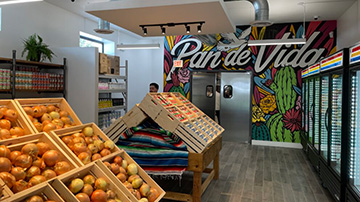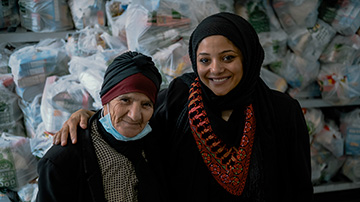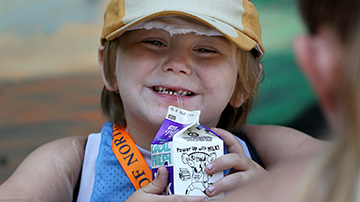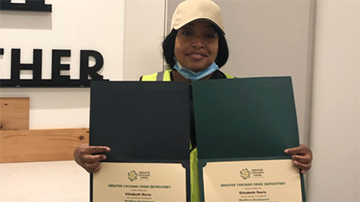
Investing in food equity
Diana Franco has lived in Little Village all her life.
She grew up down the street from New Life Centers of Chicagoland, a service organization on Chicago’s West Side, where she participated in after-school and sports programs.
Today, Franco is giving back to her neighbors as administrative coordinator for New Life’s Pan de Vida Fresh Market. The pantry opened its doors in June 2022 with help from an equity grant provided by the Greater Chicago Food Depository. Pan de Vida operates from a colorful renovated building on South Lawndale Avenue that previously housed a corner grocery store.
“It feels amazing that the community can come in here and it’s the same thing,” she said. “It’s a grocery store, but it’s for free.”
Pan de Vida grew out of New Life’s efforts to feed its neighbors amid the COVID-19 crisis, which acutely impacted Communities of Color like Little Village. From the early months of the pandemic until Pan de Vida opened, New Life served thousands of people outdoors through its massive, weekly drive-through and walk-up distributions. This work was done in partnership with the Food Depository.
Nationally and in the Chicago metro area, Black and Latino families with children are more likely to face hunger. From June 1 to July 11, 44% of Black households with children, 28% of Latino households with children and 13% of white households with children experienced food insecurity.
The Food Depository recognizes that there are many communities we serve – specifically Black and Latino communities – that have higher needs due to years of inequity and disinvestment. In fiscal year 2022, nearly 60% of the food distributed by the Food Depository went to the 40 high priority communities that we identified in 2020 as facing the highest rates of food insecurity.
“Communities of color have long been disproportionately affected by hunger, and it only worsened during the COVID-19 pandemic. We are dedicated to making Cook County a place where everyone has equitable access to nutritious food.”
Amy Laboy, vice president of programs and community partnerships
The Food Depository’s strategy is focused on collaboration and investments in neighborhoods and partners. The goal is to break down barriers of access for Black, Indigenous and People of Color (BIPOC) populations, equitably invest in people and communities across Cook County, center work on the people served, and support our partners’ work in ways that will make long lasting, positive impact on their neighbors.
Since the start of the pandemic, the Food Depository has invested approximately $14 million into local partners to help strengthen the emergency food system in high-priority, low-income communities that predominantly serve people of color.
After losing her job due to the pandemic, Franco – who had volunteered for New Life’s other programs before – began helping out at the distributions. This led to a job, which she said feels like the perfect fit.
“I wanted to continue to help out the community and for them to see a familiar face,” she said. “I am from the neighborhood, [I wanted guests to know] I’m here to help you out – even if it’s just preparing a box or having a conversation.”
The Food Depository invested in New Life’s vision for a more permanent pantry that could support neighbors from the Lawndale neighborhood with food and other services. Thanks to the generosity of Food Depository supporters that made a grant possible, Pan de Vida was designed with the needs of the community front and center.
The site is open five days a week and currently serves 150 to 200 households per day with a variety of fresh groceries. Guests like Maria, a Little Village resident who was picking up food for her kids and grandkids during a recent distribution, are grateful for the space. Maria, 62, said she’s unable to work due to health issues, so she’s able to pick up needed items like eggs and produce.
“It has been helpful a lot,” Maria said.
Franco said seeing the pantry finally up and running has been a dream come true for Little Village – even if it wasn’t something many thought was possible before it became a reality.
“They may not have known it was a dream to them, but to us it was a dream for them,” she said.
In addition to supporting new pantries, investments were also made to help existing pantries strengthen their operations, become more sustainable and serve more people. Some of these grants have helped to fund additional cold storage capacity for fresh food, for example, or aided with other technological and capital improvements to improve the pantry experience.
Another way the Food Depository is committed to investing directly in underserved communities of color is by doing more business with local minority- and women-owned vendors. Our goal is to help create jobs and economic opportunity in historically marginalized communities. We have incorporated racial equality into our policy agenda and evolved our prepared meals strategy to purchase meals from local, minority and women-owned businesses, and community organizations.
Through crucial community collaborations like these, the Food Depository and its partners can get one step closer to ending hunger for residents in communities like Little Village.




